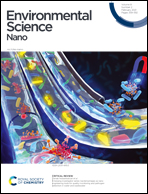Facile fabrication of Bi nanoparticle-decorated g-C3N4 photocatalysts for effective tetracycline hydrochloride degradation: environmental factors, degradation mechanism, pathways and biotoxicity evaluation†
Abstract
Metallic Bi nanoparticle-decorated g-C3N4 nanosheet (BiNPs/g-C3N4) heterostructures are fabricated by employing a simple ultrasound-assisted electrostatic self-assembly method. It is observed that BiNPs with a diameter of about 7 nanometer are uniformly deposited on porous g-C3N4 nanosheet surfaces, and offer multi-active catalytic sites to effectively contact with reactants and rapidly transport photoexcited electrons. BiNPs/g-C3N4 heterostructures significantly boost the photocatalytic degradation efficiency and photocatalytic rate for tetracycline hydrochloride (TC-H). For the optimal 10 wt%-BiNPs/g-C3N4 nanocomposite, it displays a TC-H degradation efficiency of 90.7% under visible-light irradiation for 70 min. The photocatalytic rate is approximately six-times higher than that of unmodified ones. Additionally, the heterostructure performs well in repeated cycles. The combination heterojunction effect between BiNPs and g-C3N4 and the surface plasmon resonance (SPR) of metallic BiNPs result in the desired performance of BiNPs/g-C3N4 heterostructures. Besides, the active radical capture tests reveal that ˙O2− and h+ are dominant catalytic radicals for the photocatalytic degradation. Possible pathways for the TC-H degradation and enhanced photodegradation mechanism of the heterostructure are systematically discussed. Finally, the influences of solution conditions, including pH and coexisting ions, as well as environmental water matrices, are explored extensively. The potential toxicity of the photodegradation mixtures of TC-H is evaluated. This work provides a facile and effective method for the fabrication of metallic BiNPs/g-C3N4 nanocomposites. It also helps to fully understand the coordination effect between them, and provides an efficient photocatalytic degradation material for TC-H with a practical application prospect.



 Please wait while we load your content...
Please wait while we load your content...